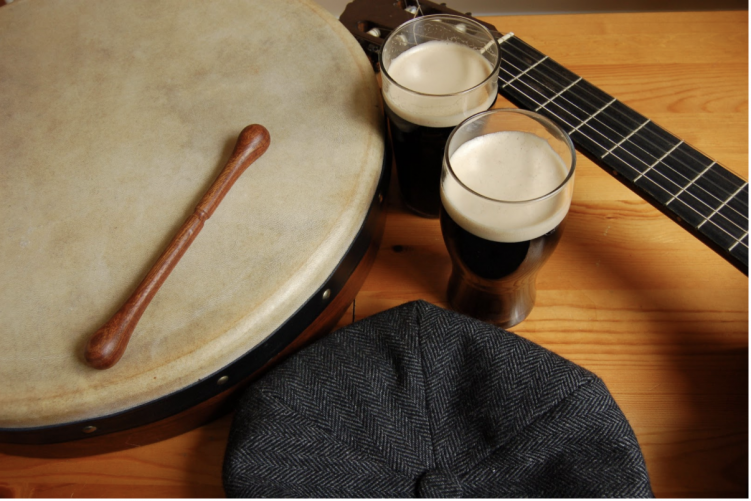Irish drum is one of the most influential musical instruments used in the history of Ireland. Any music lover will be able to tell you how beautiful it sounds. This instrument is, however, not modern, in fact, it has been used in ancient times by the Irish in local gatherings. It is thought to have played a great role in identifying Irish musical history. If you haven’t heard of an Irish drum before or don’t know much about its history, let’s walk you through some simple facts about it, its origins, and how musicians played this special instrument over the years.
The Origins
Many people think that the Irish drum is a new addition to the musical instrument family; however, it’s an ancient tool that was used in older centuries for different purposes other than producing music. Studies show that the Irish drum was actually used as a tool to carry peat back in its oldest discovery. It was then used as a musical instrument for the first time in the 15th century. Even though the instrument got its name, the bodhran, back in 1827, it has been around for longer than that. Even after the Irish drum was used as a musical instrument, it was still primitive and needed tweaking to produce the beautiful sounds we get from Irish drums today. Over the years, the Irish drum was modified and adjusted greatly. Now, modern Irish drums have deep frames and multiple sizes available depending on the choice of the buyer. They would also come in tighter skin materials and inside tunability, which enhances their music.
The Frame and Skin Material Used
When getting an Irish drum, you get to choose your preferred material for the instrument frame. Different frame materials produce different sounds and have different tunes. The two most common materials used for making the frame are plastic and wood. The frames that are made of wood, polished or crafted, produce punchier sounds. While plastic frames are super light-weight and are very durable and sustainable. For the surface of the Irish drum, synthetic materials are always available, but for the uniqueness and quality, goatskin is used. We mean dried goat skin that is polished and processed to create a surface membrane for the instrument. Some Irish drums are even made from buffalo skin; the skin material is what creates the musical sound when beaten by hands or by a stick. The skin can also be changed when it gets old to refresh the sound of the Irish drum.
The Music Output
The best thing about this instrument is that its tunes are adjustable to match every player’s preference. You can change the bass or punch of the bodhran or Irish drum using different inside tuning designs that are found inside of the instrument. This refers to the part of the instrument inside the frame and right below the skin. Bodhrans, with inside tuning, offer a wide range of sounds and can be controlled to produce a specific desired tune. For new Irish drums made after the 1960s, they are designed with screws used for tightening the skin covering the frame or the membrane. Tightening the skin of the Irish drum also allows players to adjust the density of the sound produced and gives them control over their music. There is a slight price difference between tunable Irish drums and regular ones, but the price won’t matter when you hear the sound produced by a quality modifiable Irish drum.
Sizes and Portability
The size of an Irish drum has always made it very easy to include in most folk and Celtic music gatherings. It is considered one of the most portable drums in the world. People were always able to take it to pubs and street gatherings to enjoy their jolly music while drinking beer and dancing. The instrument requires no attachments to it, and this makes it very convenient to carry around anywhere, allowing the Irish to take it to street gatherings and to play it in large groups of people.
The Irish drum comes in all different sizes maintaining its frame depth and tunability. The diameter of the frame can range anywhere from 12 to 24 inches while the depth remains relatively at the same rate to maintain the quality of the sound. It is more recommended for beginners to start with a small 12-inch-size than practice their way up to larger ones. This is why you will find more professional bodhran players using larger-sized drums. The size can also be adjusted based on the personal preferences of different players, rather than their professional level. For example, shorter people will find it more comfortable to play small Irish drums ranging from 12 to 16 inches in diameter.
Playing in Different Styles
The Irish drum can be played using a tipper or without, by using only your hands. The tipper is a small instrument used to beat the drum to create a unique sound. It’s size, diameter, and weight depend on the preference of the person using it. The Irish drum is also a very flexible musical instrument that can be played using one’s hands. People would usually use their left hands to carry the drum and use the right hand to beat the skin surface. The playing styles of the drum have also changed over the years and people play this instrument differently now than how it was initially played. The drum was made using thick woods and heavy materials for its frame back in the days, so people would traditionally play it while sitting down and place the instrument on their legs or next to their chests. Now, since the material used to make it is much lighter than how it used to be, people can play it standing up or even dancing and changing places.

The bodhran or the Irish drum is a very versatile and unique musical instrument that dates back to before the 15th century. People have been playing these drums for a long time and have used them to carry their tools since even before they were introduced as musical instruments. It can be played in many styles, and the material can be adjusted to fit personal needs. Invest in a quality tunable Irish drum, and you will be able to change the tunes produced from it and control the sound of your music. If you think you may be interested in learning more, you can check out some of our favorite free drum kits.


Irish drum is one of the most influential musical instruments used in the history of Ireland. Any music lover will be able to tell you how beautiful it sounds. This instrument is, however, not modern, in fact, it has been used in ancient times by the Irish in local gatherings. It is thought to have played a great role in identifying Irish musical history. If you haven’t heard of an Irish drum before or don’t know much about its history, let’s walk you through some simple facts about it, its origins, and how musicians played this special instrument over the years.
The Origins
Many people think that the Irish drum is a new addition to the musical instrument family; however, it’s an ancient tool that was used in older centuries for different purposes other than producing music. Studies show that the Irish drum was actually used as a tool to carry peat back in its oldest discovery. It was then used as a musical instrument for the first time in the 15th century. Even though the instrument got its name, the bodhran, back in 1827, it has been around for longer than that. Even after the Irish drum was used as a musical instrument, it was still primitive and needed tweaking to produce the beautiful sounds we get from Irish drums today. Over the years, the Irish drum was modified and adjusted greatly. Now, modern Irish drums have deep frames and multiple sizes available depending on the choice of the buyer. They would also come in tighter skin materials and inside tunability, which enhances their music.
The Frame and Skin Material Used
When getting an Irish drum, you get to choose your preferred material for the instrument frame. Different frame materials produce different sounds and have different tunes. The two most common materials used for making the frame are plastic and wood. The frames that are made of wood, polished or crafted, produce punchier sounds. While plastic frames are super light-weight and are very durable and sustainable. For the surface of the Irish drum, synthetic materials are always available, but for the uniqueness and quality, goatskin is used. We mean dried goat skin that is polished and processed to create a surface membrane for the instrument. Some Irish drums are even made from buffalo skin; the skin material is what creates the musical sound when beaten by hands or by a stick. The skin can also be changed when it gets old to refresh the sound of the Irish drum.
The Music Output
The best thing about this instrument is that its tunes are adjustable to match every player’s preference. You can change the bass or punch of the bodhran or Irish drum using different inside tuning designs that are found inside of the instrument. This refers to the part of the instrument inside the frame and right below the skin. Bodhrans, with inside tuning, offer a wide range of sounds and can be controlled to produce a specific desired tune. For new Irish drums made after the 1960s, they are designed with screws used for tightening the skin covering the frame or the membrane. Tightening the skin of the Irish drum also allows players to adjust the density of the sound produced and gives them control over their music. There is a slight price difference between tunable Irish drums and regular ones, but the price won’t matter when you hear the sound produced by a quality modifiable Irish drum.
Sizes and Portability
The size of an Irish drum has always made it very easy to include in most folk and Celtic music gatherings. It is considered one of the most portable drums in the world. People were always able to take it to pubs and street gatherings to enjoy their jolly music while drinking beer and dancing. The instrument requires no attachments to it, and this makes it very convenient to carry around anywhere, allowing the Irish to take it to street gatherings and to play it in large groups of people.
The Irish drum comes in all different sizes maintaining its frame depth and tunability. The diameter of the frame can range anywhere from 12 to 24 inches while the depth remains relatively at the same rate to maintain the quality of the sound. It is more recommended for beginners to start with a small 12-inch-size than practice their way up to larger ones. This is why you will find more professional bodhran players using larger-sized drums. The size can also be adjusted based on the personal preferences of different players, rather than their professional level. For example, shorter people will find it more comfortable to play small Irish drums ranging from 12 to 16 inches in diameter.
Playing in Different Styles
The Irish drum can be played using a tipper or without, by using only your hands. The tipper is a small instrument used to beat the drum to create a unique sound. It’s size, diameter, and weight depend on the preference of the person using it. The Irish drum is also a very flexible musical instrument that can be played using one’s hands. People would usually use their left hands to carry the drum and use the right hand to beat the skin surface. The playing styles of the drum have also changed over the years and people play this instrument differently now than how it was initially played. The drum was made using thick woods and heavy materials for its frame back in the days, so people would traditionally play it while sitting down and place the instrument on their legs or next to their chests. Now, since the material used to make it is much lighter than how it used to be, people can play it standing up or even dancing and changing places.
The bodhran or the Irish drum is a very versatile and unique musical instrument that dates back to before the 15th century. People have been playing these drums for a long time and have used them to carry their tools since even before they were introduced as musical instruments. It can be played in many styles, and the material can be adjusted to fit personal needs. Invest in a quality tunable Irish drum, and you will be able to change the tunes produced from it and control the sound of your music. If you think you may be interested in learning more, you can check out some of our favorite free drum kits.
Related Content: